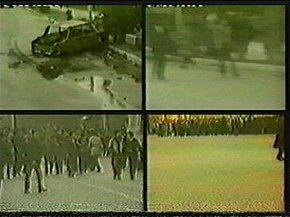Sumgait pogrom
| Sumgait pogrom | |
|---|---|

Images captured from a videotape show burnt automobiles and the massive throngs of rioters on the streets of Sumgait.
|
|
| Location | Sumgait, Azerbaijan, Soviet Union |
| Date | February 26 – March 1, 1988 |
| Target | Local Armenian population |
|
Attack type
|
Murder, rape, riot |
| Deaths | Official statistics: 26-32 Unofficial: up to hundreds |
|
Non-fatal injuries
|
Unknown |
The Sumgait pogrom (Armenian: Սումգայիթի ջարդեր, Sumgayit'i ĵarder lit.: "Sumgait massacres"; Azerbaijani: Sumqayıt hadisələri lit.: "Sumgait events") was a pogrom that targeted the Armenian population of the seaside town of Sumgait in Azerbaijan in late February 1988. The pogrom took place during the early stages of the Karabakh movement. On February 27, 1988, mobs made up of ethnic Azerbaijanis formed into groups and attacked and killed Armenians on the streets and in their apartments; widespread looting and a general lack of concern from police officers allowed the situation to continue for three days.
The Armenian civilian residents of Sumgait, including women and children, were slaughtered with exceptional brutality.
On February 28, a small contingent of Ministry of Internal Affairs (MVD) troops entered the city and unsuccessfully attempted to quell the rioting. More professional military units entered with tanks and armored personnel vehicles one day later. Government forces imposed a state of martial law and curfew and brought the crisis to an end. The official death toll released by the Prosecutor General of the USSR (tallies were compiled based on lists of named victims) was 32 people (26 Armenians and 6 Azerbaijanis), although some have revised this figure up into the hundreds.
The civil violence in Sumgait was unprecedented in scope and was widely covered in the Western press. It was greeted with general astonishment in Armenia and the rest of the Soviet Union since ethnic feuds in the country were largely suppressed by the government, which had promoted policies such as internationalism, fraternity of peoples, and socialist patriotism to avert such conflicts. The massacre, together with the Nagorno-Karabakh conflict, presented a major challenge to the reforms being implemented by Soviet leader Mikhail Gorbachev. Gorbachev was later criticized for his perceived slowness in reacting to the crisis.
...
Wikipedia
